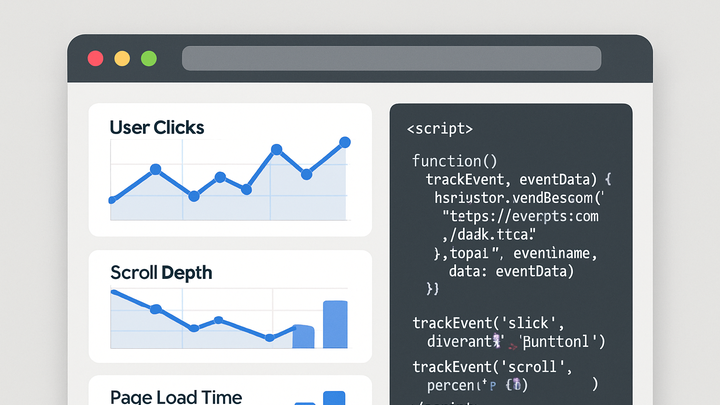Published on 2025-06-26T04:43:01Z
What is Frontend Analytics? Examples and Best Practices
Frontend analytics is the practice of instrumenting client-side code to capture and analyze user interactions directly in the web browser. Unlike traditional server-side analytics, frontend analytics monitors events such as clicks, scrolls, form submissions, and performance metrics like page load times in real time. This granular visibility helps teams optimize user experience, troubleshoot issues faster, and make data-driven product decisions. With growing privacy regulations and the deprecation of third-party cookies, many frontend analytics solutions (e.g., PlainSignal) offer cookie-free tracking to maintain compliance. Tools like Google Analytics 4 also support frontend event tracking through enhanced measurement features and custom tagging. By shifting data collection to the client side, organizations can reduce server load, enhance data accuracy, and achieve faster insights.
Frontend analytics
Captures and analyzes user interactions directly in the browser to optimize UX, performance, and privacy compliance.
Understanding Frontend Analytics
This section explains the core concept of frontend analytics, how it differs from traditional approaches, and its key components.
-
Definition
Capturing and processing user interaction data within the browser to generate actionable insights.
-
Purpose
Provide real-time visibility into user behavior and site performance for faster decision-making.
-
Core components
Key building blocks that make up a frontend analytics solution.
-
Data collection
Client-side scripts that record events like clicks and page loads.
-
Data processing
Aggregating and filtering raw event data for meaningful reports.
-
Data visualization
Dashboards and charts that present metrics and trends to end users.
-
Why Frontend Analytics Matters
Explores the benefits of using frontend analytics and its impact on user experience, performance, and privacy.
-
User behavior insights
Understand how users interact with your site to optimize workflows and content.
-
Heatmaps
Visual maps showing where users click and scroll.
-
Click tracking
Recording click events to identify popular links and buttons.
-
Scroll depth
Measuring how far users scroll on pages.
-
-
Performance optimization
Monitor technical metrics to identify and fix slow or broken experiences.
-
Page load time
Tracking time taken for pages to become interactive.
-
Resource utilization
Measuring CPU, memory, and network usage in the browser.
-
-
Privacy compliance
Implement analytics in a way that respects user privacy and legal requirements.
-
Cookie-less tracking
Using fingerprinting or local storage instead of third-party cookies.
-
Consent management
Integrating with consent banners and obtaining user permissions.
-
Comparison of SaaS Solutions
A side-by-side look at PlainSignal and Google Analytics 4 for frontend analytics use cases.
-
PlainSignal
A lightweight, cookie-free analytics platform focused on simplicity and privacy.
-
Cookie-free
Tracks visitors without relying on cookies or personal identifiers.
-
Simple setup
Minimal code snippet required to start collecting data.
-
Gdpr-compliant
Designed to meet strict European privacy regulations.
-
-
Google analytics 4
A feature-rich analytics tool with extensive customization and integration options.
-
Rich feature set
Offers advanced funnels, path analysis, and audience building.
-
Complex configuration
Requires careful setup of events and user properties.
-
Event-driven model
Uses a flexible schema to capture diverse user interactions.
-
Implementation Example
Step-by-step guide to setting up PlainSignal on your website to start collecting frontend analytics data.
-
Including PlainSignal script
Add the tracking script to your HTML to initialize data collection.
-
Code snippet
<link rel="preconnect" href="//eu.plainsignal.com/" crossorigin /> <script defer data-do="yourwebsitedomain.com" data-id="0GQV1xmtzQQ" data-api="//eu.plainsignal.com" src="//cdn.plainsignal.com/plainsignal-min.js"></script>
-
-
Verifying data collection
Confirm that events are being sent and received correctly in your analytics dashboard.
-
Debug console
Use browser dev tools to check network requests to PlainSignal endpoints.
-
Dashboard review
Log in to PlainSignal or GA4 to validate incoming data and event counts.
-
Best Practices and Common Pitfalls
Key recommendations to ensure accurate, efficient, and compliant frontend analytics implementation.
-
Maintain data privacy
Collect only the data you need and respect user consent settings.
-
Data minimization
Avoid unnecessary personal data and restrict retention periods.
-
Anonymization
Mask or hash user identifiers to protect privacy.
-
-
Optimize script loading
Ensure analytics scripts do not hinder page performance.
-
Async and defer
Load scripts asynchronously to prevent render blocking.
-
Bundle optimization
Use bundle splitting or CDNs to reduce script size and latency.
-
-
Ensure data quality
Implement checks to maintain the integrity and usefulness of your analytics data.
-
Validation
Set up data validation rules and alerts for missing or malformed events.
-
Monitoring
Regularly review dashboards and anomaly checks to detect tracking issues.
-
